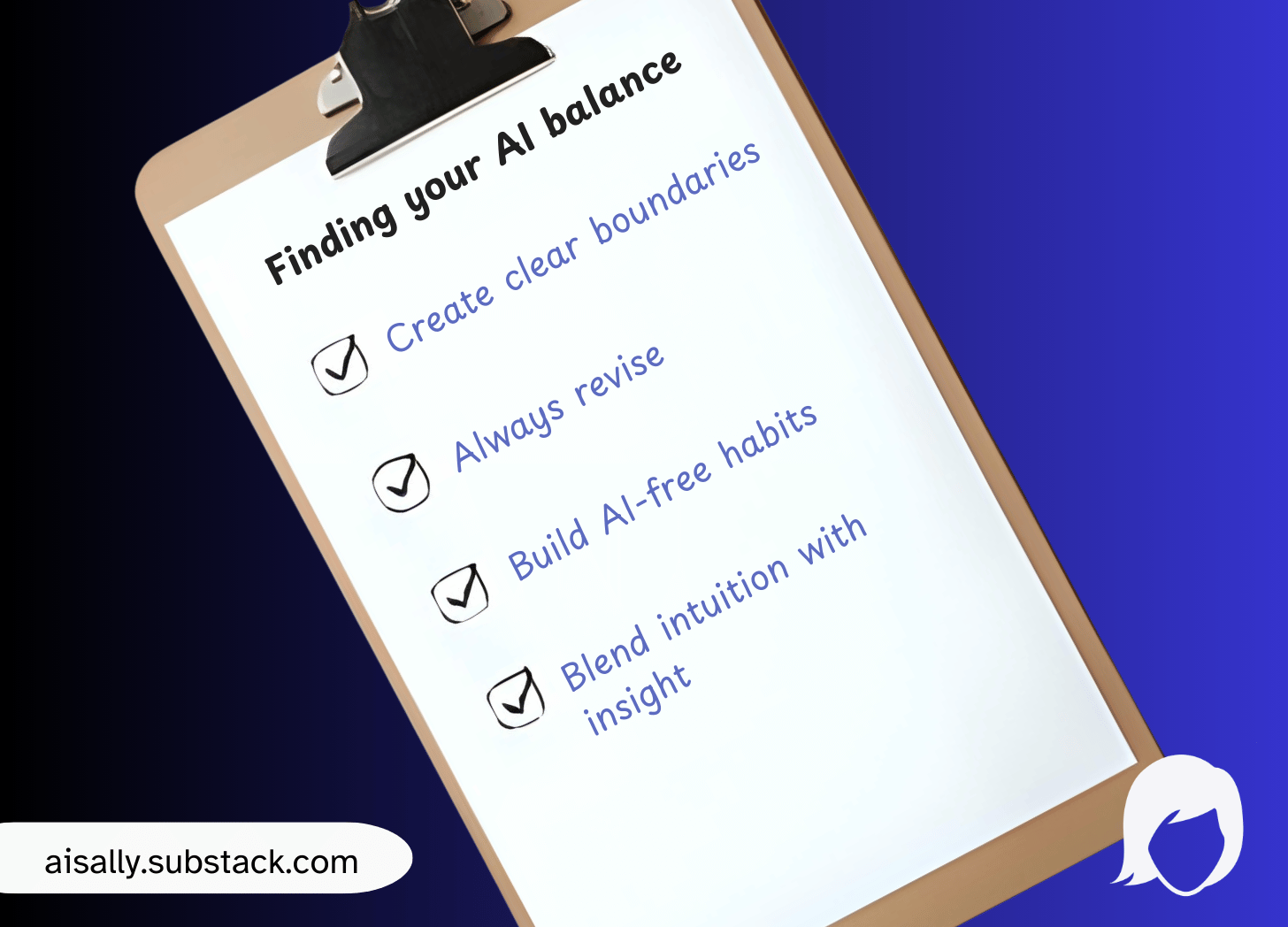How much AI is too much? Striking the right balance
What overusing AI really costs and how to stay authentic

Have you ever hired a personal trainer who insisted on lifting the weights for you? The job gets done but your muscles don’t grow, and you miss the point of training in the first place. That’s what relying too heavily on AI can feel like: faster results on the surface, but less strength in the long run.
I’ve caught myself here too. One late night, I let an AI tool draft an email for me. It looked polished, but when I reread it, it didn’t sound like me at all. It was like a stranger had borrowed my keyboard. That tiny disconnect was enough to make me rethink how I was leaning on AI.
With smart tools becoming everyday companions in the workplace, the question for many of us is simple: how much AI is too much? Let’s explore how to avoid AI fatigue, use technology with intention, and keep your authentic voice intact.
Why getting the balance right matters
AI can supercharge productivity. It helps us sift through reports, draft content, and schedule meetings in just a few clicks. But when does helpful become harmful?
Overreliance on AI can:
Erode our own skills
Flatten our unique voices
Disconnect us from colleagues and clients
Research shows that workers exposed to constant automation often report AI fatigue - a mix of loneliness, stress, and declining well-being.12 It’s a bit like GPS: fantastic for unfamiliar routes, but if you never bother remembering the way, you’ll struggle without it.
The best path forward is a partnership that blends AI’s efficiency with the quirks, empathy, and creativity only humans can bring.

Signs of AI fatigue: how to know if you’re overusing tools
Many professionals now rely on AI in subtle and not-so-subtle ways, from quick report generation to managing social posts. But how do you know if you’ve crossed the line?
Copy-pasting without reviewing: letting outputs sail straight from the screen to your boss.
Emails “don’t sound like you”: colleagues notice when communication becomes a little too perfect—and a little too impersonal.
Decision anxiety: feeling stuck until an AI tool double-checks or suggests something.
Diminishing returns: spending more time polishing AI drafts than you would creating your own.
Take the story of a communications manager: at first, AI sped up their reports. But soon, their team noticed the tone felt generic, and client engagement slipped. Authenticity, it turns out, matters more than automation when it comes to relationships and trust.
Practical ways to use AI effectively—without losing yourself
AI should be your helpful assistant, not your stand-in. Here are ways to work smarter without losing your voice:
Start with AI, but always finish with you. Think of the outputs as rough drafts, not final products, and take the time to personalise them so your unique voice and judgment shine through.
AI works best when you let it handle routine tasks such as data summaries, brainstorms, or scheduling. These are the low-effort, high-repetition jobs where automation saves time. But when it comes to complex decisions or sensitive conversations, those should remain firmly in your hands.
Another way to get the most out of AI is to ask for options rather than definitive answers. The technology excels at generating possibilities, but it’s your role to supply the context, judgment, and final direction.
And most importantly, always protect the final sign-off. Humans should have the last word on key decisions, especially in areas involving ethics, compliance, or relationships. This ensures that while AI supports the process, it never replaces the responsibility that only you can carry.
For example, think of a marketing consultant using AI like a quick sketchpad. The AI tosses out half-formed campaign ideas (some clever, some a bit out there) and then she swoops in with her red pen. The final copy sparkles with the client’s brand voice, polished and unmistakably theirs.
Real-world balancing acts
Professionals are already shaping healthy AI habits:
A café owner leans on AI to take the grind out of the daily admin—automated scheduling, quick invoice generation, and tidy records. But when it comes to his suppliers, he reaches for a pen and card. Every thank-you note is handwritten to reflect his personality and gratitude. It’s a small touch, but it keeps relationships feeling genuine in a way no algorithm can match.
An HR manager uses AI to draft job descriptions and policy documents, shaving hours off his workload. But he doesn’t just hit “send.” He reshapes the language so it reflects his company’s tone, which is friendly, approachable, and true to their workplace culture. The result? Clearer, faster communication that still feels like it belongs to the people inside the organisation and not a machine.
A financial adviser uses AI to crunch numbers and create neat, data-rich reports. What used to take half a day now takes half an hour. But she saves her energy for the real work: face-to-face conversations with clients. That’s where she listens, explains, and guides decisions with empathy, making sure people feel cared for, not processed.
Simple steps for finding your AI balance
Create clear boundaries
One of the simplest ways to avoid over-relying on AI is to draw some firm lines around how you use it. Think about which tasks are best left to people; things like performance reviews, sensitive conversations, or anything that involves nuance and empathy. Then identify where AI genuinely lightens the load, like data entry, drafting summaries, or juggling calendars. By making that distinction upfront, you can enjoy the efficiency of AI without letting it creep into areas where your human judgment and presence matter most.
Always revise
Even the most impressive AI-generated draft is only a starting point. Tools can miss subtle tone shifts, cultural context, or the quirks that make your communication feel personal. Taking a few extra minutes to reread, adjust, and add your own touch ensures that the final product sounds like you, not like a polished but generic robot voice. That small investment of time keeps your work authentic and helps build trust with whoever’s on the receiving end.
Blend intuition with insight
AI is fantastic at laying out possibilities. It can suggest options you might not have considered or spark a fresh angle on a tired problem. But the real magic happens when you bring your intuition to the table. You’re the one who knows your team, your client, or your audience best. Use the AI suggestions as raw material, then refine them with your own perspective so the outcome feels both smart and human.
Build “AI-free” habits
It might feel counterintuitive, but sometimes the best way to strengthen your relationship with AI is to step away from it. Try brainstorming on paper, sketching out ideas on a whiteboard, or walking through a problem without digital help. These AI-free moments keep your creative muscles strong and ensure you don’t lose touch with your own problem-solving skills. Like taking handwritten notes in a meeting, it may feel slower, but it often sparks insights you wouldn’t get any other way.
FAQs: common questions about using AI
Is it bad to use AI too much at work?
Not inherently, but overuse can lead to AI fatigue, weaker communication skills, and a loss of authenticity.
How do I avoid AI fatigue?
Set boundaries: use AI for repetitive tasks, but keep sensitive or creative work human-led.
What’s the right balance between AI and human creativity?
Let AI handle the heavy lifting so you have more time and headspace for the work only you can do - connecting, leading, and creating.
Keeping the human spark
The healthiest workplaces treat AI as a partner, not a replacement. When used well, AI clears the clutter so you can focus on what really matters: building trust, making thoughtful decisions, and growing your unique strengths.
So, where could you let AI make life easier without losing your personal spark? I’d love to hear your stories. After all, finding balance is something we’re all working out together.
Randstad. AI fatigue in the workplace: what your employees really think, 3 June 2025.
The Conversation. (Bertelli, Matheus; Pexels). Major survey finds most people AI regularly at work - but almost half admit to doing so inappropriately, 29 April 2025.




